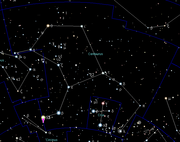Alpha Centauri
|
|
- This article is about the star system. For the computer game, see Sid Meier's Alpha Centauri.
Alpha Centauri (α Cen / α Centauri) is the brightest star system in the southern constellation of Centaurus, and is the fourth brightest star in the sky, with a total visual magnitude of −0.01. It is too far south to be visible in most of the northern hemisphere.
It is also, with Proxima Centauri, the closest star system to Earth, at 4.2–4.4 light-years. That makes it a logical choice as "first port of call" for science fiction speculation about space travel.
| Contents [hide] |
Names
It bears the proper name Rigil Kentaurus (often shortened to Rigil Kent), derived from the Arabic phrase Al Rijl al Kentaurus, meaning "foot of the centaur," but is nonetheless usually referred to by its Bayer designation Alpha Centauri. Another alternative name is Toliman from a Hebrew word meaning "the heretofore and the hereafter". It is also sometimes known as Bungula, possibly from the Latin word ungula meaning "hoof". It and Beta Centauri (nearby as seen in the Earth's night skies, but actually many light-years away) are the "Pointers" to the Southern Cross.
Alpha Centauri A is also known as HD 128620, HR 5459, CP-60°5483, GCTP 3309.00A, and LHS 50. Alpha Centauri B is also known as HD 128621, HR 5460, GCTP 3309.00B, and LHS 51.
System components
Alpha_Centauri_relative_sizes.png
Alpha Centauri is a triple star system. It consists of two main stars, Alpha Centauri A and Alpha Centauri B (which form a binary star together) at a distance of 4.36 ly, and a dimmer red dwarf named Proxima Centauri at a distance of 4.22 ly. The larger member of the binary star, Alpha Centauri A, is similar to the Sun, but a little larger and brighter. Like the Sun, its spectral type is G2 V. The smaller of the two, Alpha Centauri B, is dimmer, with a spectral type of K1 V. The two orbit one another elliptically (e=0.52), approaching as close as 11.2 astronomical units (2×10−4 ly) and receding to 35.6 AU (6×10−4 ly)with a period of just under 80 years. Hence the sum of the two masses is <math>23.4^3/80^2=2.0<math> times that of the Sun (see formula).
These two stars are about 5 to 6 billion years old.
The red dwarf Proxima Centauri is about 13,000 astronomical units away from Alpha Centauri (1 ly = 63,241 AU, hence this is 0.21 ly, about 1/20 of the distance between Alpha Centauri and the Sun, it is 0.14 ly closer to us) and may be in orbit about it, with a period on the order of 500,000 years or more. For this reason, Proxima is sometimes referred to as Alpha Centauri C. However, it is not clear if it really is in orbit, although the association is unlikely to be entirely accidental as it shares approximately the same motion through space as the larger star system.
Seen from Earth, Proxima is separated by 2 degrees from Alpha Centauri A and B (about 4 times the angular diameter of the full Moon), and the latter are at an angular distance of up to 40" from each other.
The closest neighbours to the Alpha Centauri system are the Sun and Barnard's star (1.98 pc or 6.47 ly), which is also the next nearest star from Earth, at a distance of 5.96 ly.
Possibility of planet formation
Computer models of planetary formation suggest that terrestrial planets would be able to form close to both Alpha Centauri A and B, but that gas giant planets similar to our Jupiter and Saturn would not be able to form because of the binary stars' gravitational effects. Given the similarities in star type, age and stability of the orbits it has been suggested that this solar system may hold one of the best possibilities for extraterrestrial life. However, some astronomers have speculated that any terrestrial planets in the Alpha Centauri system may be dry because it is believed that Jupiter and Saturn were crucial at directing comets into the inner solar system and providing the inner planets with a source of water.
Sky appearance from Alpha Centauri
Viewed from Alpha Centauri, the sky would appear very much as it does to us with most of the constellations such as Ursa Major and Orion being unchanged. However, Centaurus would be missing its brightest star and our Sun would appear as a 0.5-magnitude star in Cassiopeia. Roughly speaking, the \/\/ of Cassiopeia would become a /\/\/, with the Sun at the leftmost end, closest to ε Cassiopeiae. The position can easily be plotted as RA 02h39m35s, dec +60°50', or antipodal to Alpha Centauri's position as seen from Earth.
Nearby very bright stars such as Sirius and Procyon would be in very different positions, as would Altair to a lesser extent. Fomalhaut and Vega would appear somewhat displaced as well.
Proxima Centauri would be an inconspicuous 4.5 magnitude star.
Apparent movement
In about 4000 years, the proper motion of Alpha Centauri will mean that from the point of view of Earth it will appear close enough to Beta Centauri to form an optical double star. Beta Centauri is in reality far more distant than Alpha Centauri.
Facts
- Right ascension (J2000): 14h39m36.2s
- Declination (J2000): -60°50'08"
- Distance from Earth: 4.396 light years
- Parallax: 0.742"
- Apparent visual magnitude: −0.01
- Absolute visual magnitude: +4.34
- Spectral type: G2V(+K1V)
- Mass: 1.10 (A), 0.92 (B) Solar masses
- Luminosity: 1.57 (A), 0.51 (B) Solar luminosities
- Life Stage: Main Sequence
See also
External links
- Alpha Centauri (http://www.glyphweb.com/esky/stars/alphacentauri.html)
- Alpha Centauri: A Candidate for Terrestrial Planets And Intelligent Life (http://homepage.sunrise.ch/homepage/schatzer/Alpha-Centauri.html)
- Alpha Centauri System (http://www.solstation.com/stars/alp-cent3.htm)
- SIMBAD observational data (http://simbad.u-strasbg.fr/sim-id.pl?protocol=html&Ident=alpha+centauri)bg:Алфа Кентавър
de:Rigil Kentaurus fr:Alpha Centauri it:Alpha Centauri he:אלפא קנטאורי io:Alpha Centauri nl:Alpha Centauri ja:ケンタウルス座アルファ星 pl:Alfa Centauri fi:Alfa Centauri sv:Alfa Centauri uk:Альфа Центавра

